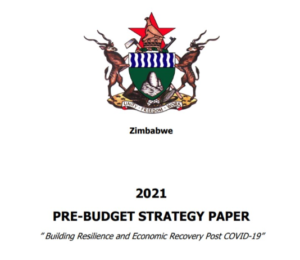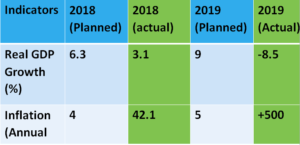
Gift Mugano
The state of the economy is characterised by the following indicators:
- Trade deficits;
- Chronic inflation (blended inflation versus Zimdollar inflation);
- Budget deficits (reference: mid-term review omitted US$75 Covid-19 allowance, ZW$18 billion stimulus package and now new salary adjustments: 300% pay increment for civil servants, hidden subsidies in fuel and electricity, etcetera);
- Massive incapacitation of workers since most workers earn salaries below the poverty datum line, which has now topped ZW$20 000;
- Large part of the year was characterised by exchange rate spikes, but which have now stabilised since the introduction of the auction system. Its sustainability is threatened by a possible increase in money supply and drought of foreign currency;
- Economic recession, which has been worsened by Covid-19;
- Dollarised economy—as expected, the economy is now dollarised but the Zimdollar has remained relevant since it is used as a medium of exchange to buy the US dollar, mitigate cost pressures while, from the government’s perspective, the Zimdollar has remained relevant because it does not have US dollar balances to pay civil servants;
- The fact of the matter is that dollarisation is with us for some time, hence the question which arises is: What currency will the 2021 budget use, considering that the government is now collecting taxes in US dollars?

State of the economy and paradigm for Vision 2030
- The current dynamics in the economy are symptoms of an underlying cause which is two-pronged, that is: (1) drought of production; and (2) country perception;
- Drought of production, on an annual basis, on average, the country spends about US$2.5 billion on goods which can be produced locally and major imports are cereals (US$500 million); soya bean (US$250 million); fruit and vegetables (US$200 million); tissue and paper (US$200 million); steel (US$300 million); fertilisers (US$150 million); pharmaceuticals (US$300 million); and a number of small imports which, when combined, becomes significant such as diapers, chewing gum, pencils, etc;
- Country perception—our brand equity as a country is at all-time low because of political tensions and various policy inconsistencies as well as policy reversals, for examples: corruption, abductions, arrests of activists, closure of EcoCash and suspension of the stock exchange, introduction of the Zimdollar and in less than a year we are back to the US dollar. This repels investments (both domestic and foreign) which is key in fostering economic growth, a which is a priori requirement for driving the country into middle-income status;
- Unfortunately, if we do not address these twin problems, we will have to forget the middle-income status.
Budget framework for 2021
- The budget framework for 2021 must be focused on enhancing productivity and production, guaranteeing policy credibility and consistency. In this regard, it must be underpinned by rigour in the development of assumptions which inform the budget;
- The 2021 national budget should provide adequate tax incentives and funding (need to strike a balance between the desire for budget surplus and running a deficit to finance production) to the Ministry of Lands, Agriculture, Water, Climate and Rural Development to support the recently launched policies:
- Pfumvudza;
- Agriculture and Food Systems Transformation Strategy;
- Livestock Growth Plan;
- National Drought Plan for Zimbabwe
- Horticultural Sector Development Strategy
- For other sectors, incentives such as local content tax breaks should be considered for value chain enhancement programmes.
Budget framework for 2021: Budget Strategy Paper assumptions
- Prospects for 2021 and beyond are based on the following broad assumptions:
- Recovery from Covid-19 pandemic;
- Resumption of global economic activity;
- Good agricultural season;
- Enhanced revenue collection;
- Sustainability of the auction system;
- Tourism and trade resumption;
- Materialisation of mining investment targets;
- Firming international mineral prices;
- Recovery in domestic aggregate demand;
- Macro stability characterised by currency stability, declining annual inflation averaging 134% and fiscal stability;
- Domestication of value chains; and
- Further control of wasteful expenditures and value of money on all expenditures.
- On the basis of the foregoing, in 2021, according to the Ministry of Finance and Economic Development, the economy is predicted to recover from a projected contraction of – 4.5% in 2020 to a growth of 7.4% in 2021, driven by consumption (2.6%) and investment (5.8%) improvements.
- These targets are hard to meet, considering the twin problems of low production and country perception (see next slide for our past experience) since the proposed policies in the BSP are not adequately addressing production.
Review of past performance of the budget framework and lessons

Lessons and how to make policies work
- In previous policy frameworks and even looking at the current Budget Strategy Paper, there is deliberate omission of the industrial policy (the name is not even mentioned) although some of the policy instruments such as value chain development are mentioned;
- There is need to place emphasis on an industrial policy which pays extra attention to sectoral policies & value chain development models—these must be outlined in the 2021 budget and must be given priority. Examples are: leather value chain, cotton value chain, pharmaceuticals, packaging, steel, fertilisers, etc;
- There is a need to place emphasis on the need for the operationalisation of a commodity exchange—this will unlock funding, markets and reduce post-harvest losses, which is key considering a possible glut of grains in 2021.
- There is need to inclusive consultations (powered by evidence) (not ticking the box) with various stakeholders in their own respective categories (academia, business, civil society, legislators, development partners). This must be done with an open mind.
- The submissions made from the parliamentary consultations and from other stakeholders should be considered in the 2021national budget and the National Development Strategy (NDS). We have not seen it but we hear that it will be launched in October 2020—we need to avoid being given a platform to review it when it is launched—because for obvious reasons it will look like we are there just to critique policies for the sake of it.
About the writer: Prof Mugano is executive director of Africa Economic Development Strategies (www.aeds-africa.com) and visiting professor at Durban University of Technology, South Africa. He presented this strategy paper recently at Parliament’s Pre-Budget meeting.